Interior design is much more than simply choosing stylish furniture or picking out a trendy paint color – it has a profound impact on how we feel, behave, and function in our spaces. A well-designed environment can boost your mood, reduce stress, improve sleep, and even promote healthier habits. As more people recognize the connection between wellness and their surroundings, interior design is increasingly viewed as a key player in supporting mental, emotional, and physical health.
The Psychology of Space
Our brains respond to our environments in powerful ways. For example, cluttered or chaotic spaces can cause anxiety and make it difficult to concentrate. On the other hand, clean, organized rooms help promote a sense of calm and control. Soft lighting, natural materials, and a thoughtful layout can encourage relaxation, creativity, or focus – depending on how the space is intended to be used. By understanding how people interact with surroundings, designers can create environments that foster well-being.
The Role of Natural Light
One of the most effective tools in wellness-focused design is natural light. Exposure to sunlight regulates the body’s circadian rhythm, which influences sleep patterns, energy levels, and even your mood. Homes and workspaces with ample windows, skylights, or glass doors tend to feel more open and uplifting. Designers can enhance natural light in a space by using light-colored walls, mirrors, and reflective surfaces to help it travel deeper into the space.
Color and Mood
Color psychology plays a vital role in how we experience space. Cool tones like soft blues and greens promote calm and clarity, making them ideal for bedrooms or meditation areas. Warm hues such as yellows and oranges can boost energy and encourage social interaction. This works well in kitchens or gathering spaces. Neutral tones create a restful background that supports relaxation and mindfulness. The right color choices can transform a room from chaotic to serene – or from dull to invigorating.
Furniture, Layout, and Movement
Comfortable furniture and thoughtful layouts can encourage healthy habits and improve quality of life. Ergonomic seating, open flow between rooms, and multifunctional areas promote physical ease and reduce stress. Designing spaces that encourage movement – like walking paths between frequently used rooms, or home gyms – can also support an active lifestyle. Even the placement of a reading nook by a window can nudge someone to unwind more often.
A Personal Sanctuary
Ultimately, wellness-centered interior design is about creating spaces that feel good to be in. It’s not about copying trends – it’s about tuning into how a space will make you feel and adjusting it to better support your goals, routines, and sense of peace. Whether you’re designing a home office, a bedroom, or your entire house, prioritizing wellness in your interior design choices can lead to a happier and healthier life.
There are a number of ways to increase wellness just by shaping the design of your home. For more information on how to use your space to generate a more positive well-being, reach out to the experts at à la carte DESIGN today.
